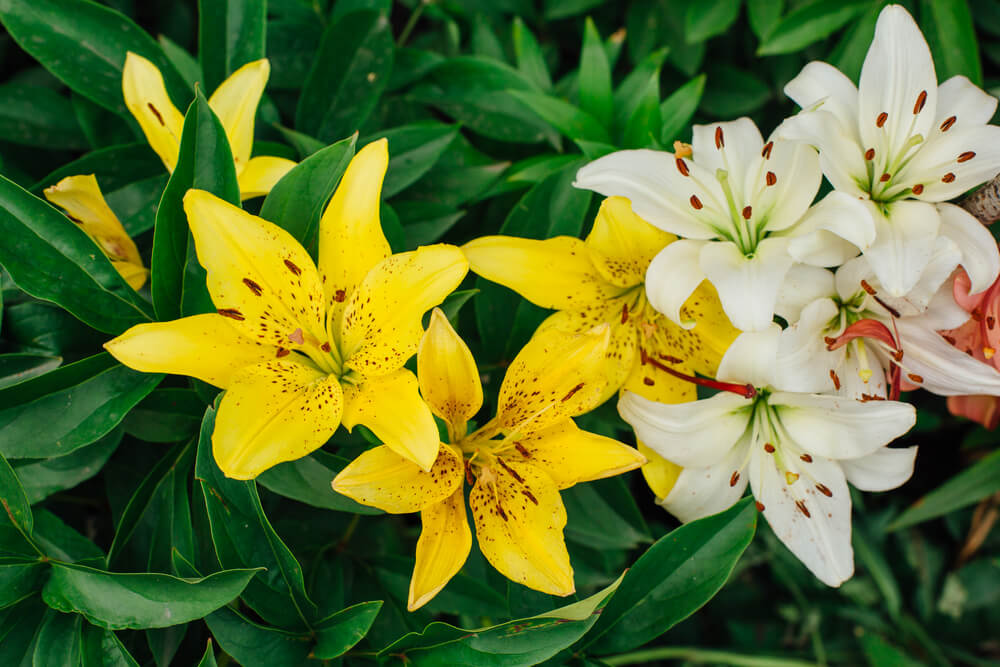Tiger Lilies (Lilium henryi) are prolific perennials known for their showy orange flowers spotted with black dots. Sometimes called a “ditch lily” because it often grows wild in trough-like regions. Tiger Lily’s original home was China and Japan, but you can grow Tiger Lilies in your home, too, by learning more about Tiger Lily care.
Tiger Lily Tales
It’s nearly impossible to miss a Tiger Lily’s presence in the garden. Their flowers open on top of stems that can grow up to 5 feet tall. They have dark-green leaves shaped like little lances. The color sets off the blossoms as a perfect backdrop.
A mature Tiger Lily bulb can produce 40 flowers in suitable conditions. Over time, you can carefully replant your Tiger Lily, which grows more dark, round bulbs. If you put your potted plant outside periodically, it will attract hummingbirds and other pollinators. Hummingbirds love the Tiger Lily’s bright colors. So grab a book and a chair into your yard, and enjoy the show.
Giving someone a Tiger Lily means you are delighted with them and all they’ve achieved.
Key Takeaways
- Do not grow Tiger Lilies indoors if you have cats or dogs. The petals are poisonous for pets.
- Tiger Lilies are hardy plants, making them easier to grow indoors successfully.
- Tiger Lilies are sunbathers. They love full-sun locations near your windows.
- If you plant your Tiger Lilies in the fall, the plant can concentrate on growing healthy roots.
- Tiger Lilies are late bloomers among perennials.
8 Approaches for Growing Tiger Lilies in Your Home
1. When to Plant Tiger Lilies
Tiger Lilies benefit from planting in early spring or late fall. Autumn offers you the benefit of being able to gather seeds, which are ready for planting. Better still, the natural growth cycle of Tiger Lilies, growing more bulbils, begins in the fall. So, pot your bulbs in October or November (some say as early as August). Expect blossoms in summer.
Make sure your bulbs point upward in the soil. Depending on the size of your pot, you can put in more than one bulb, planted about 6” down.
Tiger Lily Symbolism: The Tiger Lily is rich in meaning around the world. Because of the bright flowers, it often represents self-confidence and prosperity. During the Victorian Era, the Language of Flowers says Tiger Lily represents humble pride. In Japan, Tiger Lilies are often gifts for people settling into a new home, graduating, or beginning a new job because they are an emblem of wealth. Superstition claims that planting Tiger Lilies in and around the home keeps ghosts away.
2. How to Plant Tiger Lilies

Wait until just before you plan to plant your Tiger Lilies to get bulbs from your garden store. Make sure you choose a pot that has good drainage. Once you’ve put the bulbs point upward, 6” deep in the soil, they will benefit from applying long-term flower fertilizer.
You will find your Lilies adapt quickly to containers. Look around your house to find a sunny window where they can receive 6-8 hours of sunlight daily. If the area is too shady, the stems move toward the sun and may fall over.
By the way, if you ever wish, you can take your Tiger Lily bulbs outside. The outdoor planting needs are the same, but the bulb bundles should be about 9” apart for spacing.
Benefits of Tiger Lilies
In Naturopathic medicine, the Tiger Lily bulb is in the healer’s kit for decreasing inflammation and water retention. It improves blood flow, and you can also use them as an expectorant. In Korea, people use Tiger Lily for coughs, sore throats, and allaying stress, depression, and angst.
3. Growing Tiger Lilies in Containers
Tiger Lilies do well indoors in a pot. Look for one that’s at least 9” deep. Fill it with high-quality potting soil.
The key to success is keeping the soil moist but not swamped. If the bottom of the pot has standing water, the bulb will rot. Your bulb requires the most water while it’s actively growing. Check the moisture. In general, Lily needs watering once a week.
Save your coffee grounds and mix them with high-acid soil. Tiger Lilies thrive on the coffee’s potassium, nitrogen, and phosphorus. Adding some loam is also a good way to make your plant happy.
After that, Tiger Lilies are independent greenery. They won’t need a lot of care and return year after year. Keep an eye on the drainage hole in your pot. If you see roots growing out of it, you need to upgrade to a large pot. This is the time at which you can check the root ball to see if it has new bulbs you can divide. Then you’re ready to pot some more Tiger Lilies!
Tiger Lily in the Zodiac: Tiger Lily is the flower for those born under the sign of Aries the Ram (March 21-April 19). Since Mars governs Aries, it’s no wonder the flower represents bravery, assertiveness, ambition, and determination. An Aries stands out in a crowd, just like Tiger Lilies, which make a bold statement as a bouquet, in your garden, or your home.
4. Tiger Lily Varieties

There are approximately nine types of Tiger Lily, all of which are cross-breeds. These cultivars include Asiatic Hybrids, Pine Lily, Leopard Lily, and Kenton Lily.
Asiatic Hybrids: The major color for these flowers are plum and peach, making for a beautiful lily. Asiatic Hybrids bloom in early summer, some blossoms measuring up to 8” wide!
Easter Lily: A pure white flower, Easter Lilies have trumpet-like flowers and announce Spring’s arrival. People use it as a celebratory flower, usually seen in Easter decorations. White Lilies appear in the Bible, symbolizing rebirth, hope, and purity.
Pine Lily: Also known as Catesby’s Lily and Leopard Lily. This is another plant offering showy flowers. The petals are reddish-orange, sporting an inner base with yellow and purple dots. They blossom from summer to late fall. The plant bears the name of an esteemed nature historian, Mark Catesby.
Color Symbolism: Most plants have some type of meaning associated with them. Flowers are no exception. The bright orange color is energetic and filled with positivity. Pink Tiger Lilies are an emblem of happiness and joy. Among Buddhists, Tiger Lilies embody the virtues of compassion and mercy.
5. Tiger Lily Winter Care
Tiger Lilies go dormant in winter. They can withstand freezing temperatures, but you don’t have to worry since your plants are indoors.
Cut off all the flowers at the end of your container-grown lilies’ summer cycle. Let the leaves die back naturally. Slowly reduce the amount of watering. When all the leaves are dead, discontinue watering. You can now dig up the bulb.
If you’re fortunate to have one is splitting into offshoots, separate them for other pots. Keep the bulbs in an area with good air circulation. The garage is one option. Don’t be tempted to bring the pots into the house during winter. It will deter flower production in the summer.
Tiger Lilies: Ancient Roots
If you look throughout history, Tiger Lilies have made an appearance nearly everywhere. The first record of this plant dates to 1580 BCE (The Minoan Period). Once they came to Greece, it took a starring role in the mythology of Hera, the Queen of the Gods. Romans felt that Tiger Lily was sacred to Venus, the goddess of beauty (on look at this flower and the association is apparent).
6. Basic Tiger Lily Needs & Common Problems

Tiger Lily’s needs and common problems have ties with each other. For example, this flower needs loose soil with excellent drainage. And the most common problem with Tiger Lilies is over-watering!
Watch for yellowing, droopy leaves, and the lack of blooms. Drain out any excess water. Then, only water when the top 2” of soil dries out. If this approach doesn’t work, you may have to repot your Lily, giving it amended soil.
Secondly, Tiger Lilies are sun worshipers, needing 6-8 hours of light daily. So, if you put your indoor pot in a shady place, it will at first bend toward the light. Then the stem bends, and your plant may not return.
Weddings & Birthdays: If you were born in May, the Lily is your birth flower. Lilies are also a traditional blossom for 30th wedding anniversaries.
7. Tiger Lily Common Pests and Diseases
Tiger Lillies are pretty hardy. The main disease they may develop is the mosaic virus. It spreads through infected seeds, insects, weeds, and proximity to an infected plant. Signs of the mosaic virus include:
- Blisters on the leaves
- Reduced growth
- Stems drying out quickly
The reality is you are buying bulbs and sprouted flowers from a space where they can be exposed. Know your horticulturist. Unfortunately, there is no cure. If you have any seeds or bulbs from an infected plant, those can carry the virus, too. It’s best if you dispose of it and start over.
In the pest department, you have scarlet lily beetles, slugs, and aphids. It’s pretty easy to spot lily beetles, especially if you check the undersides of your leaves where they nibble, as do their larvae. They prefer the leaves but will eat buds and stems as well.
The key sign of an Aphid infestation is seeing white fuzz on top of your newly opening flower. Slugs eat flowers and leaves, leaving noticeable holes as they feed.
Is it a Real Lily?
While some plants bear the word “lily” in their name, many are not real lilies. Daylily and Peace Lily are two. In order to be a true lily, the greenery must belong to the genus “Lilium.”
8. Tiger Lilies on the Menu

There was a time when cooking with flowers was common. Tiger Lilies are edible. The bulbs taste a bit like a turnip. Wrap them up and roast them like a potato. But don’t stop there. Add some fresh petals to a salad, or use the plant shoots in stir fry. Both the flowers and shoots are slightly sweet.
If you’re feeling fancy, use a whole flower head, and stuff it with meat, cheese, or sage stuffing. Treat them to batter, and deep fry them. Note that Tiger Lilies don’t handle refrigeration well. Pluck them when you plan to use them.
Lily Zoning: The USDA has a list of growing zones for nearly every plant you can think of. According to their charts, Tiger Lily spans zones 3 – 9, and this is where they will thrive. The extreme low temperatures for these regions range from -40 to 25F. Of course, you don’t have to worry if you’re taking care of your lilies indoors.
8 Guidelines for Successfully Growing Tiger Lily Indoors
Having a fresh blooming tiger lily in your home certainly makes a bold statement. The tall stalks are graceful and a lovely, living green addition to any house. There is absolutely no reason you cannot grow these indoors unless you have cats. Even if you think you have a safe spot away from the kitty, they have a way of getting into things and Lily is toxic for them. Lily’s care is not difficult. As a result, the Tiger Lily makes an excellent choice if you’re just starting an indoor garden. Better still, you can transplant them outdoors with little problem, should you wish.
Frequently Asked Questions About Palm Tiger Lilies
What is special about the tiger lily?
Tiger Lilies are unique, stunning flowers. The petals curve softly backward, showing the blossom’s black spots that make it look like a tiger. Hence the name. It’s low maintenance, perfect for busy people, and has a light, sweet scent.
How rare is a tiger lily?
Even though Tiger Lilies are an Asian species, they are not rare in the United States.
Is tiger lily flower toxic?
Tiger Lilies are not toxic to humans. Cats, however, can become very sick by eating daylilies, easter lilies, stargazer lilies, and red lilies (there are more). Symptoms of ingestion include vomiting, hiding, extreme third, Diarrhea, and seizures.
While less harmful to your pup, dogs usually experience gastrointestinal upset. There have been no reported cases of dogs who have died from eating Tiger Lily. The signs of ingestion are the same as those of cats.
How fast do tiger lilies grow?
If you planted your bulbs in fall or spring, you can expect flowers by mid to late summer. Once you see the plant sprout, you have 2-3 months to wait.
Are tiger lilies easy to keep?
Yes. In fact, it might be a good choice for novice gardeners. Once you have bulbs established in good, semi-loose soil, you’re good to go. Get them into the sunlight, and water them once a week. Just make sure not to drown them.
How do you keep tiger lilies blooming?
When you see deadhead flowers, trim them off. This will encourage more blossoms.
How do you take care of potted tiger lilies?
First, sort through your bulbs, disposing of any that show signs of mold or feel mushy. You’ll need a medium to large pot with proper drainage. You can also add a few small rocks at the bottom to help with drainage. Plant your bulbs, tip up, two inches apart in soil mixed with some sand (you can buy commercial blends). Add a slow-release fertilizer when the plant is actively growing. Now, just keep the pot in a sunny location, and water the plant sparingly. Once a week should do (test the soil first to see if it is still moist. If so, wait).
How long do potted tiger lilies last, and do they come back every year?
Once your indoor Tiger Lily blossoms, the flowers only last one to two weeks.
- www.tigerlilyfoundation.org/
- blogs.bellevue.edu/library/index.php/2020/11/tiger-lily-lilium-lancifolium/
- www.gardenia.net/plant-variety/lilium-tigrinum-tiger-lilies#:~:text=Perennial%3A%20Tiger%20lilies%20are%20bulbous,with%20strongly%20lance%2Dshaped%20leaves.
- www.gardeningknowhow.com/ornamental/bulbs/lily/tiger-lily-care.htm
- www.almanac.com/plant/lilies



